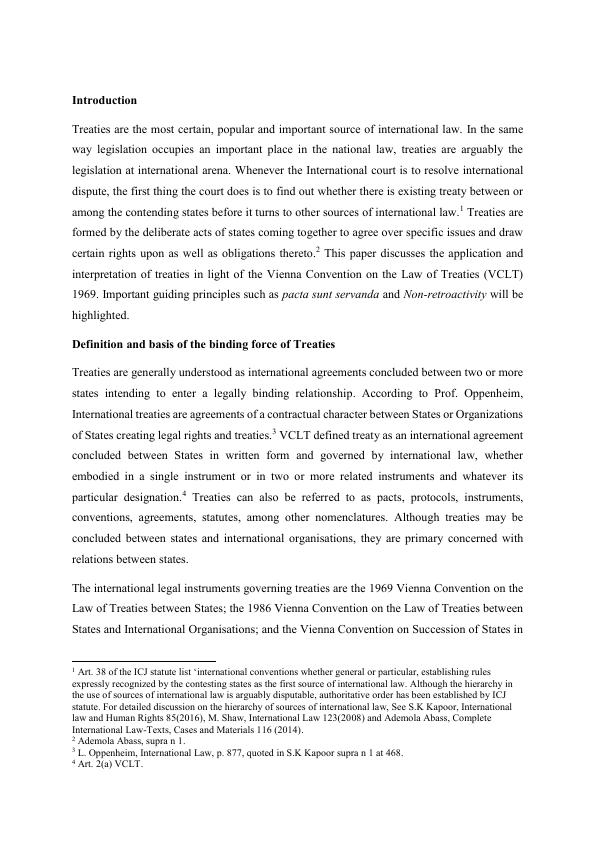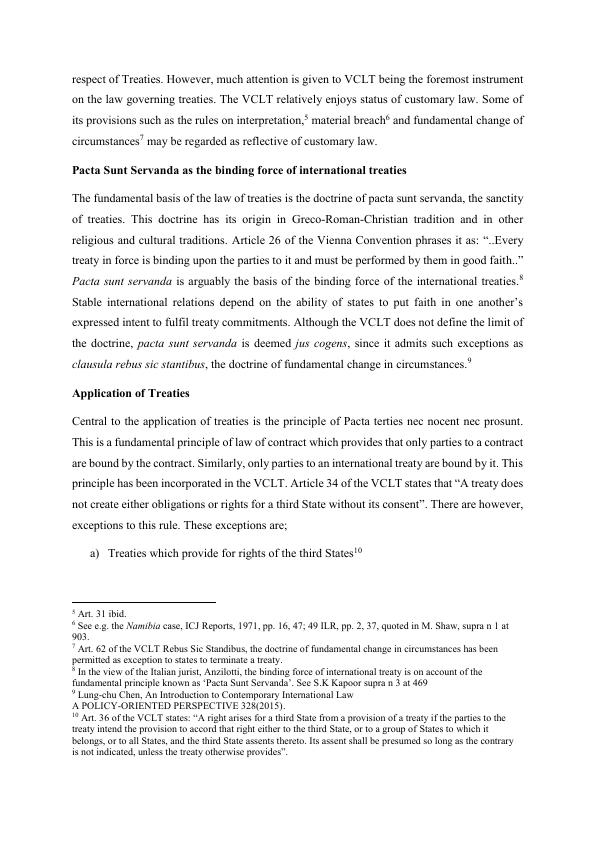Ask a question from expert
International Law Assignment PDF
7 Pages2434 Words155 Views
Added on 2022-01-18
International Law Assignment PDF
Added on 2022-01-18
BookmarkShareRelated Documents
Sharda University School of Law
LLM (International Law)
Subject: Public International Law
Assignment
On
Application and interpretation of Treaties: The governing Principles
and Practice
Submitted to
Mr. Ankur Sharma
Assistant Prof, SOL
Submitted by:
Peter Garang Geng
Submission Date:
23/04/2018
LLM (International Law)
Subject: Public International Law
Assignment
On
Application and interpretation of Treaties: The governing Principles
and Practice
Submitted to
Mr. Ankur Sharma
Assistant Prof, SOL
Submitted by:
Peter Garang Geng
Submission Date:
23/04/2018

Introduction
Treaties are the most certain, popular and important source of international law. In the same
way legislation occupies an important place in the national law, treaties are arguably the
legislation at international arena. Whenever the International court is to resolve international
dispute, the first thing the court does is to find out whether there is existing treaty between or
among the contending states before it turns to other sources of international law.1 Treaties are
formed by the deliberate acts of states coming together to agree over specific issues and draw
certain rights upon as well as obligations thereto.2 This paper discusses the application and
interpretation of treaties in light of the Vienna Convention on the Law of Treaties (VCLT)
1969. Important guiding principles such as pacta sunt servanda and Non-retroactivity will be
highlighted.
Definition and basis of the binding force of Treaties
Treaties are generally understood as international agreements concluded between two or more
states intending to enter a legally binding relationship. According to Prof. Oppenheim,
International treaties are agreements of a contractual character between States or Organizations
of States creating legal rights and treaties.3 VCLT defined treaty as an international agreement
concluded between States in written form and governed by international law, whether
embodied in a single instrument or in two or more related instruments and whatever its
particular designation.4 Treaties can also be referred to as pacts, protocols, instruments,
conventions, agreements, statutes, among other nomenclatures. Although treaties may be
concluded between states and international organisations, they are primary concerned with
relations between states.
The international legal instruments governing treaties are the 1969 Vienna Convention on the
Law of Treaties between States; the 1986 Vienna Convention on the Law of Treaties between
States and International Organisations; and the Vienna Convention on Succession of States in
1 Art. 38 of the ICJ statute list ‘international conventions whether general or particular, establishing rules
expressly recognized by the contesting states as the first source of international law. Although the hierarchy in
the use of sources of international law is arguably disputable, authoritative order has been established by ICJ
statute. For detailed discussion on the hierarchy of sources of international law, See S.K Kapoor, International
law and Human Rights 85(2016), M. Shaw, International Law 123(2008) and Ademola Abass, Complete
International Law-Texts, Cases and Materials 116 (2014).
2 Ademola Abass, supra n 1.
3 L. Oppenheim, International Law, p. 877, quoted in S.K Kapoor supra n 1 at 468.
4 Art. 2(a) VCLT.
Treaties are the most certain, popular and important source of international law. In the same
way legislation occupies an important place in the national law, treaties are arguably the
legislation at international arena. Whenever the International court is to resolve international
dispute, the first thing the court does is to find out whether there is existing treaty between or
among the contending states before it turns to other sources of international law.1 Treaties are
formed by the deliberate acts of states coming together to agree over specific issues and draw
certain rights upon as well as obligations thereto.2 This paper discusses the application and
interpretation of treaties in light of the Vienna Convention on the Law of Treaties (VCLT)
1969. Important guiding principles such as pacta sunt servanda and Non-retroactivity will be
highlighted.
Definition and basis of the binding force of Treaties
Treaties are generally understood as international agreements concluded between two or more
states intending to enter a legally binding relationship. According to Prof. Oppenheim,
International treaties are agreements of a contractual character between States or Organizations
of States creating legal rights and treaties.3 VCLT defined treaty as an international agreement
concluded between States in written form and governed by international law, whether
embodied in a single instrument or in two or more related instruments and whatever its
particular designation.4 Treaties can also be referred to as pacts, protocols, instruments,
conventions, agreements, statutes, among other nomenclatures. Although treaties may be
concluded between states and international organisations, they are primary concerned with
relations between states.
The international legal instruments governing treaties are the 1969 Vienna Convention on the
Law of Treaties between States; the 1986 Vienna Convention on the Law of Treaties between
States and International Organisations; and the Vienna Convention on Succession of States in
1 Art. 38 of the ICJ statute list ‘international conventions whether general or particular, establishing rules
expressly recognized by the contesting states as the first source of international law. Although the hierarchy in
the use of sources of international law is arguably disputable, authoritative order has been established by ICJ
statute. For detailed discussion on the hierarchy of sources of international law, See S.K Kapoor, International
law and Human Rights 85(2016), M. Shaw, International Law 123(2008) and Ademola Abass, Complete
International Law-Texts, Cases and Materials 116 (2014).
2 Ademola Abass, supra n 1.
3 L. Oppenheim, International Law, p. 877, quoted in S.K Kapoor supra n 1 at 468.
4 Art. 2(a) VCLT.

respect of Treaties. However, much attention is given to VCLT being the foremost instrument
on the law governing treaties. The VCLT relatively enjoys status of customary law. Some of
its provisions such as the rules on interpretation,5 material breach6 and fundamental change of
circumstances7 may be regarded as reflective of customary law.
Pacta Sunt Servanda as the binding force of international treaties
The fundamental basis of the law of treaties is the doctrine of pacta sunt servanda, the sanctity
of treaties. This doctrine has its origin in Greco-Roman-Christian tradition and in other
religious and cultural traditions. Article 26 of the Vienna Convention phrases it as: “..Every
treaty in force is binding upon the parties to it and must be performed by them in good faith..”
Pacta sunt servanda is arguably the basis of the binding force of the international treaties.8
Stable international relations depend on the ability of states to put faith in one another’s
expressed intent to fulfil treaty commitments. Although the VCLT does not define the limit of
the doctrine, pacta sunt servanda is deemed jus cogens, since it admits such exceptions as
clausula rebus sic stantibus, the doctrine of fundamental change in circumstances.9
Application of Treaties
Central to the application of treaties is the principle of Pacta terties nec nocent nec prosunt.
This is a fundamental principle of law of contract which provides that only parties to a contract
are bound by the contract. Similarly, only parties to an international treaty are bound by it. This
principle has been incorporated in the VCLT. Article 34 of the VCLT states that “A treaty does
not create either obligations or rights for a third State without its consent”. There are however,
exceptions to this rule. These exceptions are;
a) Treaties which provide for rights of the third States10
5 Art. 31 ibid.
6 See e.g. the Namibia case, ICJ Reports, 1971, pp. 16, 47; 49 ILR, pp. 2, 37, quoted in M. Shaw, supra n 1 at
903.
7 Art. 62 of the VCLT Rebus Sic Standibus, the doctrine of fundamental change in circumstances has been
permitted as exception to states to terminate a treaty.
8 In the view of the Italian jurist, Anzilotti, the binding force of international treaty is on account of the
fundamental principle known as ‘Pacta Sunt Servanda’. See S.K Kapoor supra n 3 at 469
9 Lung-chu Chen, An Introduction to Contemporary International Law
A POLICY-ORIENTED PERSPECTIVE 328(2015).
10 Art. 36 of the VCLT states: “A right arises for a third State from a provision of a treaty if the parties to the
treaty intend the provision to accord that right either to the third State, or to a group of States to which it
belongs, or to all States, and the third State assents thereto. Its assent shall be presumed so long as the contrary
is not indicated, unless the treaty otherwise provides”.
on the law governing treaties. The VCLT relatively enjoys status of customary law. Some of
its provisions such as the rules on interpretation,5 material breach6 and fundamental change of
circumstances7 may be regarded as reflective of customary law.
Pacta Sunt Servanda as the binding force of international treaties
The fundamental basis of the law of treaties is the doctrine of pacta sunt servanda, the sanctity
of treaties. This doctrine has its origin in Greco-Roman-Christian tradition and in other
religious and cultural traditions. Article 26 of the Vienna Convention phrases it as: “..Every
treaty in force is binding upon the parties to it and must be performed by them in good faith..”
Pacta sunt servanda is arguably the basis of the binding force of the international treaties.8
Stable international relations depend on the ability of states to put faith in one another’s
expressed intent to fulfil treaty commitments. Although the VCLT does not define the limit of
the doctrine, pacta sunt servanda is deemed jus cogens, since it admits such exceptions as
clausula rebus sic stantibus, the doctrine of fundamental change in circumstances.9
Application of Treaties
Central to the application of treaties is the principle of Pacta terties nec nocent nec prosunt.
This is a fundamental principle of law of contract which provides that only parties to a contract
are bound by the contract. Similarly, only parties to an international treaty are bound by it. This
principle has been incorporated in the VCLT. Article 34 of the VCLT states that “A treaty does
not create either obligations or rights for a third State without its consent”. There are however,
exceptions to this rule. These exceptions are;
a) Treaties which provide for rights of the third States10
5 Art. 31 ibid.
6 See e.g. the Namibia case, ICJ Reports, 1971, pp. 16, 47; 49 ILR, pp. 2, 37, quoted in M. Shaw, supra n 1 at
903.
7 Art. 62 of the VCLT Rebus Sic Standibus, the doctrine of fundamental change in circumstances has been
permitted as exception to states to terminate a treaty.
8 In the view of the Italian jurist, Anzilotti, the binding force of international treaty is on account of the
fundamental principle known as ‘Pacta Sunt Servanda’. See S.K Kapoor supra n 3 at 469
9 Lung-chu Chen, An Introduction to Contemporary International Law
A POLICY-ORIENTED PERSPECTIVE 328(2015).
10 Art. 36 of the VCLT states: “A right arises for a third State from a provision of a treaty if the parties to the
treaty intend the provision to accord that right either to the third State, or to a group of States to which it
belongs, or to all States, and the third State assents thereto. Its assent shall be presumed so long as the contrary
is not indicated, unless the treaty otherwise provides”.

End of preview
Want to access all the pages? Upload your documents or become a member.
Related Documents
The Formation of International Treatieslg...
|15
|2655
|313
National Law in New Zealandlg...
|9
|2200
|56
International trade Law PDFlg...
|28
|10143
|172